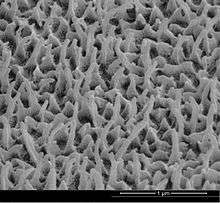Greta oto
| Glasswinged butterfly | |
|---|---|
 | |
| Scientific classification | |
| Kingdom: | Animalia |
| Phylum: | Arthropoda |
| Class: | Insecta |
| Order: | Lepidoptera |
| Family: | Nymphalidae |
| Tribe: | Ithomiini |
| Genus: | Greta |
| Species: | G. oto |
| Binomial name | |
| Greta oto William Chapman Hewitson, 1837 | |
The Glasswinged butterfly (Greta oto) is a brush-footed butterfly, and is a member of the subfamily Danainae, tribe Ithomiini, subtribe Godyridina.[1][2]
G. oto adults also exhibit a number of interesting behaviors, such as long migrations and lekking among males.
Description
The wings are transparent, with a span of 5.6 to 6.1 cm (2.2 to 2.4 in).[2] The butterfly's most common English name is glasswinged butterfly, and its Spanish name is "mariposa de cristal", which means "crystal butterfly". The tissue between the veins of its wings looks like glass, as it lacks the colored scales found in other butterflies.[3] The opaque borders of its wings are dark brown, sometimes tinted with red or orange, and its body is dark in color.
Origin of the wings' transparency
The transparency of its wings results from the combination of three properties: first, from the low absorption of the visible light by the material constituting its wings, second, from the low scattering of the light passing through the wings and finally, from the low reflection of the light impinging on the wings surface.

The latter occurs for a broad range of incident wavelengths, covering the whole visible spectrum, and of incidence angles. This broadband and omnidirectional anti-reflection property originates from nano-pillars standing on the wing's surface which ensures a gradient of refractive index between the incident medium (air) and the wing's membrane. Those nano-pillars, non-periodically arranged on the wing's surface, possess a high aspect ratio (height divided by radius) in excess of 6, where the radii are below the wavelengths of the visible light. Besides, they feature a random height and width distribution, which is directly responsible for the smooth refractive index gradient and thereby for the broadband and omnidirectional anti-reflection properties. These properties are further improved by the presence of pedestals at the base of the nano-pillars.[4]
Distribution
Adult glasswings can be found mostly from Central to South America as far south as Chile.[2] They can migrate great distances and have been documented as far north as Mexico and Texas.[5]
Feeding
G. oto visits common flowers like lantana, but prefers to lay its eggs on plants of the tropical Solanaceae genus Cestrum.[2] The green caterpillars[6] feed on these toxic plants and are perhaps toxic to predators through secondary chemicals stored in their tissues; caterpillar chemical extracts are unpalatable to Paraponera clavata ants.[7] Adults are also assumed to be toxic,[8] but their toxicity results mainly from males feeding on flowers (e.g., Asteraceae) whose nectar contains pyrrolizidine alkaloids. These same alkaloids also are converted into pheromones by the males and used to attract females.
References
- ↑ Lamas, G. (Ed.). (2004). Checklist: Part 4A. Hesperioidea - Papilionoidea. In: Heppner, J. B. (Ed.), Atlas of Neotropical Lepidoptera. Volume 5A. Gainesville, Association for Tropical Lepidoptera; Scientific Publishers.
- 1 2 3 4 Henderson, Carrol L. (2002). "Greta oto". Field guide to the Wildlife of Costa Rica. Austin, Texas: University of Texas Press. p. 56. ISBN 0-292-73459-X. OCLC 46959925. Retrieved 9 March 2009.
- ↑ Creation, Volume 30, No 4, page 56
- ↑ Siddique, R. H.; Gomard G.; Hölscher H. (2015). "The role of random nanostructures for the omnidirectional anti-reflection properties of the glasswing butterfly". Nature Communications. 6. doi:10.1038/ncomms7909.
- ↑ Jenkins, Nathaniel (August 12, 2014). "Featured Creature: Glasswinged Butterfly". PBS. Retrieved August 4, 2015.
- ↑ Hill, S. K.. (1996). Behaviour and natural history of Greta oto in captivity (Lepidoptera: Nymphalidae: Ithomiinae), Tropical Lepidoptera, 7: 161-165.
- ↑ Dyer, L. A. (1995). Tasty generalists and nasty specialists? Antipredator mechanisms in tropical lepidopteran larvae, Ecology, 76: 1483-1496.
- ↑ Brown, K. S. (1984). Adult obtained pyrrolizidine alkaloids defend ithomiine butterflies against a spider predator, Nature, 309: 707-709.
Further reading
- Hall, S. K. (1996). "Behaviour and natural history of Greta oto in captivity". Tropical Lepidoptera. 7 (2).
- Johnsen, Sönke (December 2001). "Hidden in Plain Sight: The Ecology and Physiology of Organismal Transparency" (PDF). Biological Bulletin. Marine Biological Laboratory. 201 (3): 301–318. doi:10.2307/1543609. JSTOR 1543609. PMID 11751243.
- Binetti, Valerie R.; Jessica D. Schiffman; Oren D. Leaffer; Jonathan E. Spanier; Caroline L. Schauer (2009). "The natural transparency and piezoelectric response of the Greta oto butterfly wing". Integrative Biology. 1 (4): 324–9. doi:10.1039/b820205b. PMID 20023733.
External links
| Wikimedia Commons has media related to Greta oto. |
- Batty, Paul W. (2004). "The Glasswing Greta oto".
- Greta oto, EoL
- Greta oto - Glasswing, Captain's European Butterfly Guide
- Video of captive Glasswing butterflies lekking